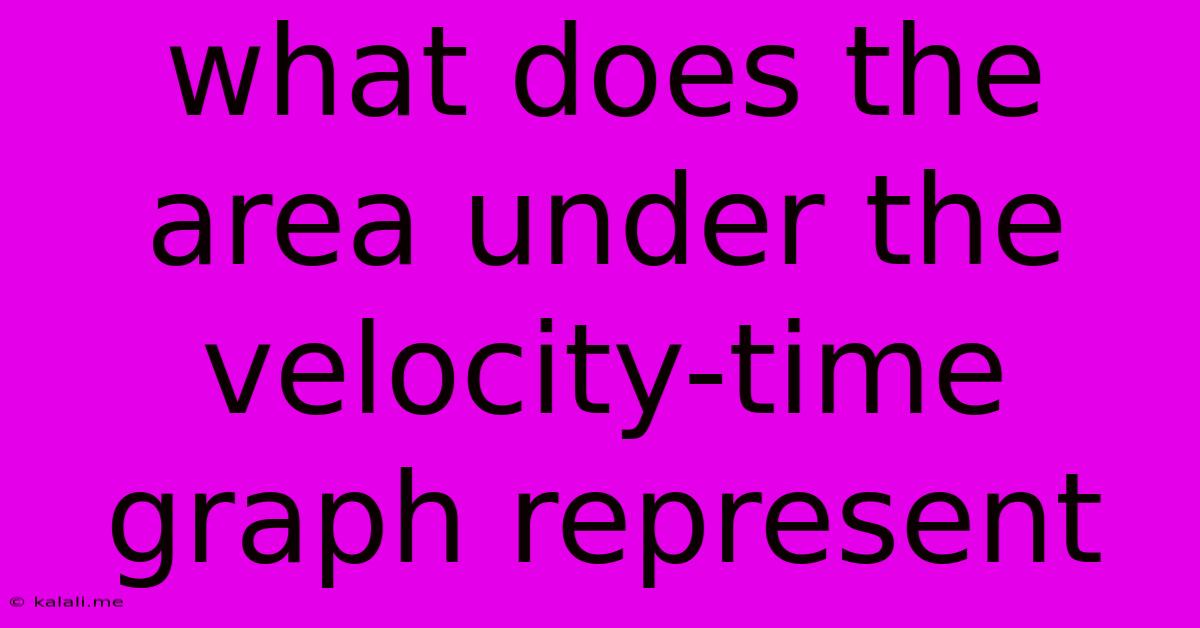What Does The Area Under The Velocity-time Graph Represent
Kalali
Jun 14, 2025 · 3 min read

Table of Contents
What Does the Area Under the Velocity-Time Graph Represent?
The area under a velocity-time graph represents the displacement of an object. This is a fundamental concept in physics and understanding it is crucial for analyzing motion. This article will explore this relationship in detail, providing clear explanations and examples to solidify your understanding. It's a key concept for students studying kinematics and mechanics.
Understanding this relationship is vital for anyone working with motion problems, from calculating the distance traveled by a car to determining the trajectory of a projectile.
Deriving the Relationship: Velocity, Time, and Displacement
Recall the definition of average velocity:
Average velocity = (change in displacement) / (change in time)
Or, mathematically:
v_avg = Δx / Δt
Where:
v_avgis the average velocityΔxis the change in displacementΔtis the change in time
Rearranging this equation, we get:
Δx = v_avg * Δt
Now, consider a velocity-time graph. The area of a rectangle under the graph is simply the base (Δt) multiplied by the height (v_avg). Therefore, the area of this rectangle represents the displacement (Δx).
What About Non-Uniform Motion?
The above explanation is straightforward for uniform motion (constant velocity). But what happens when velocity changes over time (non-uniform motion)? The graph becomes a curve rather than a straight line.
In this case, we can divide the area under the curve into many small, narrow rectangles. The area of each small rectangle approximates the displacement during that small time interval. By summing the areas of all these rectangles, we get an approximation of the total displacement.
As we make the rectangles narrower and more numerous, the approximation becomes increasingly accurate. In the limit, as the width of the rectangles approaches zero, the sum of the areas becomes the definite integral of the velocity function with respect to time. This integral precisely represents the total displacement.
Therefore, even with varying velocity, the area under the velocity-time graph still represents the displacement.
Examples and Applications
Let's illustrate this with a few examples:
-
Constant Velocity: If the graph shows a straight horizontal line, the area is a simple rectangle. The calculation is straightforward: displacement equals velocity multiplied by time.
-
Uniform Acceleration: If the graph shows a straight line with a positive slope (constant acceleration), the area is a trapezoid or a triangle (if initial velocity is zero). The displacement can be calculated using appropriate geometric formulas or through integration.
-
Non-Uniform Acceleration: For more complex velocity-time curves, integration is necessary to determine the exact area under the curve and thus the total displacement. Numerical methods can be employed for practical calculations.
Beyond Displacement: Understanding the Significance
The area under a velocity-time graph isn't just about finding a numerical answer; it provides crucial insights into the motion of an object:
-
Total Distance Travelled vs Displacement: While the area under the curve represents the displacement (vector quantity, considering direction), the total distance travelled might be different if the object changes direction (velocity becomes negative). For total distance, you need to consider the absolute value of the velocity.
-
Understanding Motion Patterns: The shape of the curve itself provides valuable information about the object's acceleration and changes in speed. A steep slope indicates rapid acceleration or deceleration, while a flat line suggests constant velocity.
In conclusion, the area under a velocity-time graph is a powerful tool for analyzing motion. Understanding its significance allows for a deeper comprehension of kinematics and enables the solution of a wide range of motion-related problems. Whether the motion is simple or complex, the principle remains consistent: the area always represents the displacement.
Latest Posts
Latest Posts
-
A Difference Between Goods And Services Is That
Jun 14, 2025
-
Who Developed The First Psychology Laboratory
Jun 14, 2025
-
Which Of The Following Is Not A Form Of Technology
Jun 14, 2025
-
An Ion With A Positive Charge Is Called
Jun 14, 2025
-
How To Write 200 In Words
Jun 14, 2025
Related Post
Thank you for visiting our website which covers about What Does The Area Under The Velocity-time Graph Represent . We hope the information provided has been useful to you. Feel free to contact us if you have any questions or need further assistance. See you next time and don't miss to bookmark.